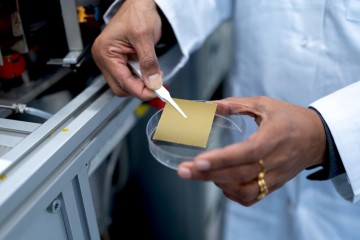- Ruhr-Universität Bochum

A Sieve for Molecules
Researchers from Bielefeld, Bochum and Yale have succeeded in producing a layer of two-dimensional silicon dioxide. This contains natural pores and can therefore be used like a sieve for molecules and ions. Scientists have been looking for such materials for some time, because they could help desalinate seawater or be used in new types of fuel cells. The team describes the fabrication process in the journal Nano Letters, published online Jan. 19, 2022. The teams led by Dr. Petr Dementyev of Bielefeld University, Prof. Dr. Anjana Devi of RUB and Prof. Dr. Eric Altman of Yale University collaborated on the work.
Natural openings in the crystal lattice
When two-dimensional materials are pierced with high precision, they can be used to screen out specific ions or molecules. Researchers have repeatedly tried to use graphene, a material made of carbon atoms, for this purpose. Since it has no natural pores, they have to be inserted artificially. But it is difficult to create holes of a defined size in graphene without permanently damaging the material, which breaks easily. This is because it loses too much stability due to the perforation. Consequently, an alternative had to be found. In the current work, the research team took advantage of the fact that the crystal lattice of two-dimensional silicon dioxide naturally has openings. They showed that these openings can be used to separate certain gases from one another.
Fabrication problematic
2D silicon dioxide has been known since 2010. However, its production was very expensive and only possible on a small scale. The researchers from Bochum, Bielefeld and Yale brought together expertise from materials chemistry, chemical engineering and chemical physics to devise a new manufacturing process. They used what is known as atomic layer deposition to deposit a single layer of silicon dioxide on a gold surface.
"We expect our results to be important for materials science worldwide," sums up Anjana Devi from the Bochum-based Inorganic Materials Chemistry group. "Such 2D membranes could be at the forefront of helping sustainable development, for example in the field of energy conversion or storage."
